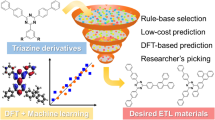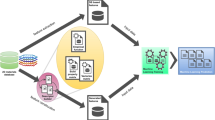Abstract
The QSPR study was performed between topological indices and glass transition temperatures (T gs) of organic light-emitting diode materials based on a diverse set of 80 compounds. A five-parameter correlation with the squared correlation coefficient R 2 = 0.9304 and an average absolute error of 7.7 K was obtained through step-wise multi-linear regression analysis with leave-one-out cross-validation. The new model proposed is predictive and requires only topological indices in the calculations and has the advantage of the relative ease in calculating the descriptors, which makes it easier to apply. The predicted results of the new model are comparable to those of the existing equation by using the Comprehensives Descriptors for Structural and Statistical Analysis approach.





Similar content being viewed by others
Abbreviations
- LOO:
-
Leave-one-out
- MLRA:
-
Multi-linear regression analysis
- OLED:
-
Organic light-emitting diodes
- QSPR:
-
Quantitative structure-property relationship
References
Tang C, Van Slyke S (1987) App Phys Lett 51:913–915
Wong K-T, Wang Z-J, Chien Y-Y, Wang C-L (2001) Org Lett 3:2285–2288
Yeh H-C, Lee R-H, Chan L-H, Lin T-YJ, Chen C-T, Balasubramaniam E, Tao Y-T (2001) Chem Mater 13:2788–2796
Wong K-T, Chien Y-Y, Chen R-T, Wang C-F, Lin Y-T, Chiang H-H, Hsieh P-Y, Wu C-C, Chou CH, Su YO, Lee G-H, Peng S-M (2002) J Am Chem Soc 124:11576–11577
Hughes G, Wang C, Batsanov AS, Fern M, Frank S (2003) Org Biomol Chem 1:3069–3077
Lee M-T, Yen C-K, Yang W-P, Chen H-H, Liao C-H, Tsai C-H, Chen CH (2004) Org Lett 6:1241–1244
Kim YS, Kim JH, Kim JS, No KT (2002) J Chem Inf Comput Sci 45:75–81
Yin S, Shuai Z, Wang Y (2003) J Chem Inf Comput Sci 43:970–977
Mattioni BE, Jurs PC (2002) J Chem Inf Comput Sci 42:232–240
García-Domenech R, Julián-Ortiz JVD (2002) J Phys Chem B 106:1501–1507
Kier LB, Hall LH (1976) Molecular connectivity in chemistry and drug research. Academic Press, New York
Kier LB, Hall LH (1986) Molecular connectivity in structure-activity analysis. Wiley, New York
Pogliani L (2000) Chem Rev 100:3827–3858
Zhong C, Yang C, Li Q (2002) Ind Eng Chem Res 41:2826–2833
Zhong C, Hu Q (2003) J Pharm Sci 92:2284–2294
ChemOffice 7.0 (2002) Inc Cambridgesoft, USA
TSAR 3.3 (2000) Oxford Molecular Ltd., USA
Wiener H (1947) J Am Chem Soc 69:17–20
Balaban AT (1982) Chem Phys Lett 89:399–404
Balaban AT (1983) Pure Appl Chem 55:199–206
Balaban AT (1986) Math Chem (MATCH) 21:115–122
Randic MJ (1975) J Am Chem Soc 97:6609–6615
Kier LB, Di Paolo T, Hall LH (1977) J Theor Biol 67:585–595
Kier LB, Hall LH (1983) J Pharm Sci 72:1170–1173
Kier LB, Hall LH (1990) Pharm Res 7:801–807
Kier LB, Hall LH (1999) Molecular structure description: the electrotopological state. Academic Press, San Diego
Kier LB (1985) Quant Struct-Act Relat 4:109–116
Hall LH, Kier LB (1992) In: Lipkowitz KB, Boyd DB (eds) Reviews in computational chemistry. Wiley, New York, pp 265–289
Kier LB, Hall LH (1999) In: Devillers J, Balaban AT (eds) Topological indices and related descriptors in QSAR and QSPR. Gordon and Breach Science Publishers, Amsterdam, pp 455–489
Topliss J, Edwards R (1979) J Med Chem 22:1238–1244
Jurs PC (1996) Computer software applications in chemistry. Wiley, New York
Acknowledgments
The authors gratefully wish to express their thanks to the reviewers for critically reviewing the manuscript and making important suggestions.
Author information
Authors and Affiliations
Corresponding author
Appendices
Appendix
The definitions of topological indices used in this work are shown below:
Wiener indices
The Wiener number, W, is the sum of distances in a molecular graph [18]. For a given connected molecular graph G
where D ij is a distance matrix of the shortest paths between any two vertices for N vertices. D ij = l ij if i ≠ j, otherwise equal to zero. l ij is the shortest distance between vertices i and j.
Balaban indices
The Balaban index, J, is the average-distance sum connectivity [19–21]. For a given connected molecular graph G
where M is the number of edges in G. μ denotes the ring number of G. In a polycyclic graph, μ is the minimum number of edges that must be removed before G becomes acyclic. \(D_{i} = {\sum\limits_{j = 1} {D_{{ij}} } }\) and D ij is defined as for the Wiener index.
Randic–Kier–Hall subgraph connectivity indices
The χ t indices may be derived from the adjacency matrix [22–24] and they are defined as
where m is the subgraph order, that is, the number of edges in the subgraph, N m is the number of type t order m subgraphs within the whole graph, and m S j is a factor defined for each subgraph as
where j denotes the particular set of edges that constitutes the subgraph and δ i is the degree of vertex i, that is, its number of edges.
Valence connectivity indices are defined similarly, substituting δ i by δ v i , defined as
where Z is the atomic number of the atom i,Z v the number of valence electrons, and h i is the number of H atoms attached to it.
Kier–Hall electrotopological state indices
Kier and Hall [25, 26] developed electrotopological state indices (E-state indices), based on the electronegativity of an atom and its local topology. The E-state (S i ) of an atom i (non-hydrogens) is calculated by evaluating the intrinsic state value (I i ) and the perturbation arising from all the other skeletal atoms (ΔI i ):
where
and: N i is the principal quantum number of atom i,δv is the count of valence electrons in the skeleton; δ the count of s electrons in the skeleton (see Randic–Kier–Hall Subgraph Connectivity Indices, earlier), ΔI i the perturbation on atom i by all other skeletal atoms j,r ij is the number of atoms in the shortest path between atoms i and j (including i and j). Electrotopological state indices of the type of atoms are obtained by summing the electrotopological states for each present type of atoms in the molecule, S T (i).
Kier–Hall Kappa indices
The Kappa indices are the basis of a method of molecular structure quantitation in which attributes of molecular shape are encoded into three indices (Kappa values) [27–29]. These Kappa values are derived from counts of one-bond, two-bond, and three-bond fragments, each count being made relative to fragment counts in reference structures which possess a maximum and minimum value for that number of atoms.
Shape flexibility index or Φ. Flexibility of a molecule is directly related to the degree of linearity and the presence of cycles and/or branching [27–29]. The Kappa alpha indices measure these factors while also taking the effects of atomic identities on shape into account. Hall and Kier found that by combining 1 κα and 2 κα indices, a further index Φ, which measured flexibility, could be defined:
Rights and permissions
About this article
Cite this article
Xu, J., Chen, B. Prediction of glass transition temperatures of OLED materials using topological indices. J Mol Model 12, 24–33 (2005). https://doi.org/10.1007/s00894-005-0282-5
Received:
Accepted:
Published:
Issue Date:
DOI: https://doi.org/10.1007/s00894-005-0282-5




